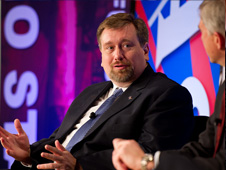Text Size
NASA Future Forum Celebrates with John Glenn
 Sen. John Glenn, left, talks with NASA Administrator Charles Bolden during a NASA Future Forum panel discussion. Photo Credit: NASA/Bill Ingalls
Sen. John Glenn, left, talks with NASA Administrator Charles Bolden during a NASA Future Forum panel discussion. Photo Credit: NASA/Bill Ingalls› Link to larger photo
 NASA Chief Technologist Mason Peck talks during a panel discussion on the importance of education to our nation's future in space, the benefit of commercialized space technology to our economy and lives here on Earth, and the shifting roles for the public, commercial and international communities in space. Photo Credit: NASA/Bill Ingalls
NASA Chief Technologist Mason Peck talks during a panel discussion on the importance of education to our nation's future in space, the benefit of commercialized space technology to our economy and lives here on Earth, and the shifting roles for the public, commercial and international communities in space. Photo Credit: NASA/Bill Ingalls
› Link to larger photo
NASA Future Forum Spotlights Technology, Innovation, Science and Education
NASA officials, scientists, engineers, technologists, students, as well as education and business leaders took part in a NASA Future Forum, held Feb. 20-21 at The Ohio State University in Columbus.
“Today, America’s space program is alive and vital,” said NASA Administrator Charles Bolden. “In the area of science and technology, we’re trying to come up with new technologies that will get us from point A to point B faster,” noting a number of initiatives now underway within NASA’s Office of the Chief Technologist.
NASA’s third Future Forum since August spotlighted the task of technology, innovation, science and education in shaping NASA’s space exploration plans that also sustain economic development here on Earth.
Stepping Stone Mission
Joining Bolden in the two-day event—and receiving a special anniversary salute was John Glenn, the first American to rocket into Earth orbit 50 years ago. Riding in his single-seat space capsule, he circuited the planet three times on Feb. 20, 1962.
“It’s good to look back,” Glenn told Forum attendees, but doing so is “a stepping stone” for looking ahead, he advised.
Glenn said that there are two kinds of exploration: Macro exploration to other destinations that show skill in keeping people alive on round-trip voyages and yield a new experience for human beings. The other is micro exploration, done on arrival to a destination, such as Earth orbit, that cultivates research beneficial to people right here on Earth, according to Glenn.
Basic fundamental research backed by an educated citizenry and investment means learning new things first, Glenn added. Doing so has given the U.S. a world leadership role in innovation and technology…“and if we ever lose that kind of lead, then we lose world leadership. I truly believe that.”
Renaissance in Technology
“NASA is experiencing a renaissance in technology,” said Mason Peck, chief technologist at NASA. "There’s been an awakening of public engagement in space exploration.”
Peck pointed out that, for the first time in many years, “NASA has a formal, funded program in space technology. This means that we’re able to pursue technologies that will shape tomorrow’s missions.”
“We’re doing so across a wide range of mission areas, and also technology readiness levels,” that is, a range of maturity from the earliest stages of innovation, all the way to technology demonstrations, Peck explained. “This is a really exciting time.” According to Peck, NASA’s space technology program is vibrant in three areas: early-stage innovation, game changing development, and cross-cutting technology demonstrations.
“There are no limits in principle to what we can be covering within the space technology program...but guided by the need to prioritize those investments,” Peck said. “It’s the right time to be investing in technology so that we’re smart going forward and can invest correctly,” he concluded.
Halo Factor
One thing that is clear is the financial crunch of today, said Caroline Wagner, director of the Battelle Center for Science and Technology Policy at The Ohio State University. “We need to find ways to do things in new ways and find new forms of leverage…new forms of funding, new partnerships,” she said.
Dan Lockney from the Office of the Chief Technologist at NASA Headquarters underscored the tangible direct and in-direct benefits of technology and innovation to society. He highlighted the many opportunities and partnerships between NASA, large and small industries, academia, and other government agencies to contribute to the global economy.
“Since NASA started in 1958, innovation has fueled our ability to get out into space to explore…and that has also fueled economic competitiveness,” Lockney said.
Carlos Grodsinsky, vice president of technology at ZIN Technologies in Cleveland, spoke of the spinoff factor within his firm by applying NASA know-how in a variety of areas, from materials science and combustion research to remote patient management. There’s a “halo factor” of working day to day with NASA, and that’s “absolutely tied to the NASA wow factor” according to Grodsinksy.
At the close of the NASA Future Forum, the top three high school winners in the Battelle Center’s Science & Technology Essay Contest were honored. One message from a student’s composition summed up the event:
“Never tell me the sky’s the limit when there are footprints on the moon. I want to be able to walk in these footprints soon and I want the world to have a chance to join me.”
› To see more photos from the event, please click here.